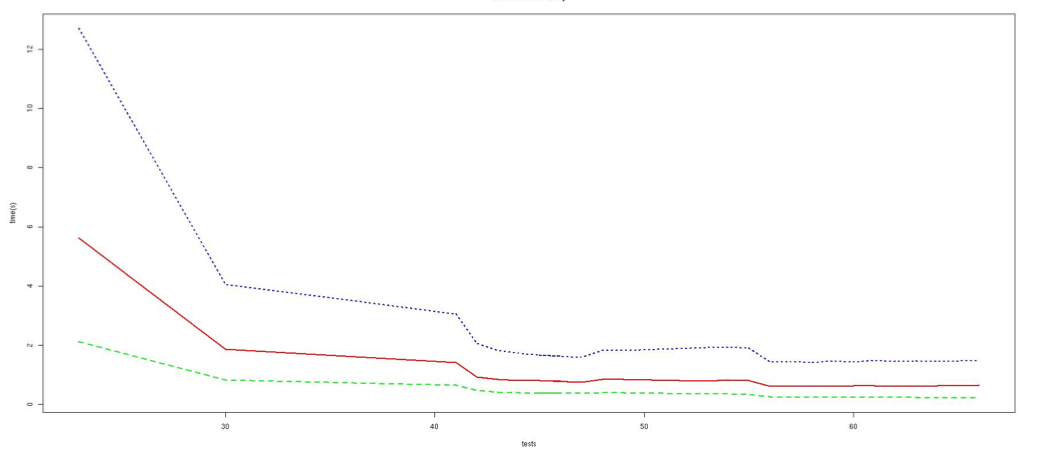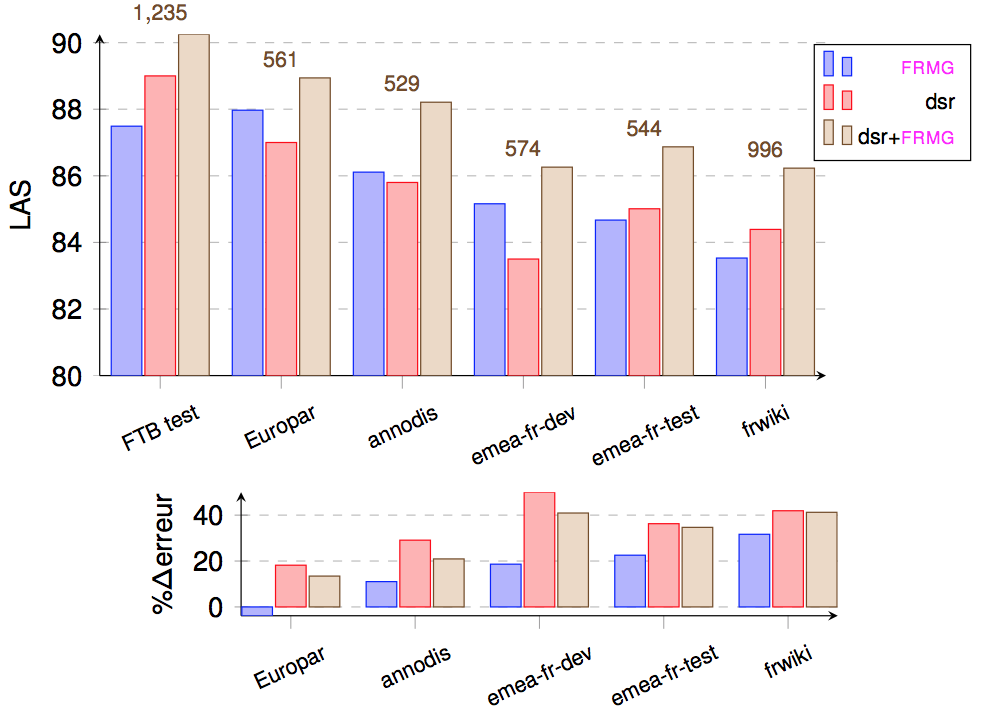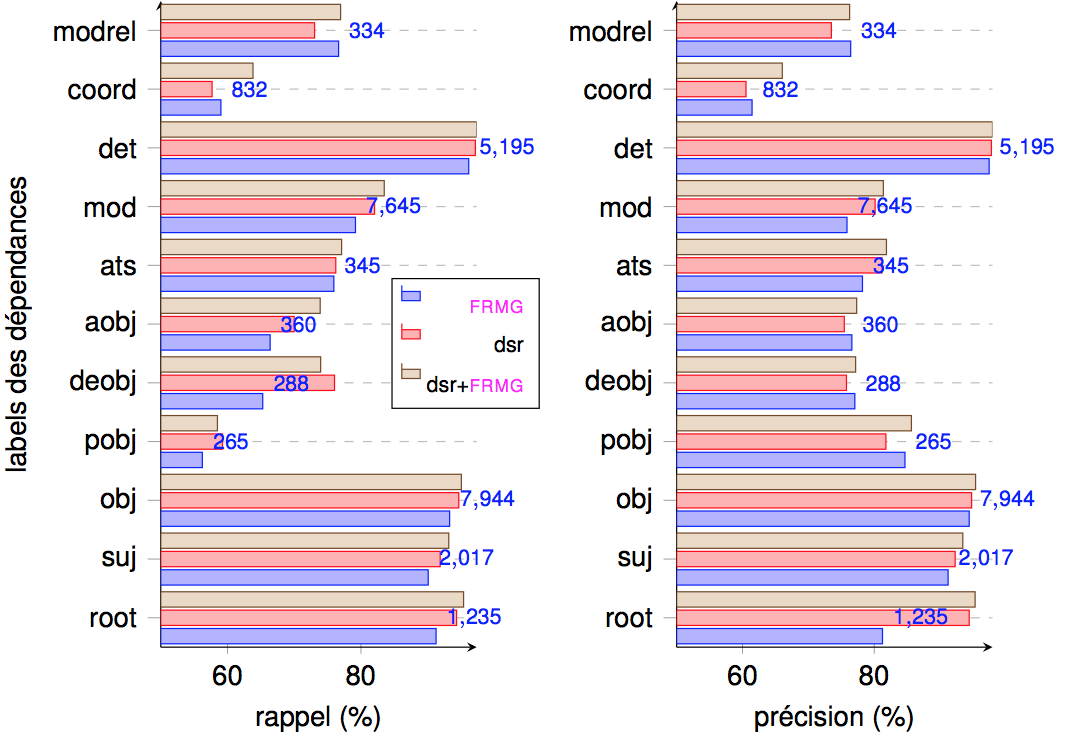Révisions
The development of FRMG was initiated in 2004 in order to participate to EASy, the first parsing evaluation campaign for French. Developing a first working version for the campaign took less than 6 months, illustrating the interest of meta-grammars to quickly design relatively large coverage grammars.
However, the last 10 years have been busy improving FRMG and have led to the development of several auxiliary tools to monitor, debug, evaluate, ..., in other word, the necessary duties of real-life grammar engineering.
Actually, improving a grammar like FRMG means to work along the 3 following axes:
- improving the coverage, with the description of more and more syntactic phenomena and ways to deal with errors in sentences (robustness)
- improving the accuracy of the parses
- improving the efficiency, ie the speed of parsing but also of the other phases (forest extraction, disambiguation, conversions)
Unfortunately, these 3 axes are not easily conciliable ! Increasing the coverage tends to degrade the efficiency and may also lead to a degradation of accuracy: a new badly constrained rare syntactic phenomena may overtake some more common phenomena. Improving efficiency may require to prune search space and loose good parses. Improving accuracy may require more disambiguation rules, more discriminative features, leading to longer disambiguation times.
Coverage
The normal way to improve coverage is of course to add new classes in the metagrammar to cover missing syntactic phenomena. This process may be helped by parsing large corpora and looking at "failed sentences", ie sentences that couldn't be parsed. When modifying the grammar, it is also important to try test suites and to re-parse corpora to check that sentences that were successful remain successful.
Actually, there may be many reasons for a sentence to fail, not necessarily because of missing syntactic phenomena. It may also comes from missing or bad lexical entries, new words, badly recognized named entities, exotic typography, spelling errors, ....
In order to better identify the source of errors, we developed error mining techniques. The algorithm is essentially a variant of EM (expectation maximization) that tries to find suspect words that tend to occur more often than expected in failed sentences and in presence of words that tend to occur in successful sentences. Error mining proved to be very useful to detect lexical issues, but also to detect exotic typographic conventions and even syntactic issues. Actually, the idea of error mining may be extended to go beyond words, by working at the level of part-of-speech, n-grams, ...
Another way to improve coverage in the robust mode of FRMG that may be used to return a set of partial parses covering a sentence that has no full parse. While interesting, the resulting partial parses tend to have a lower accuracy than the full one, and the robust mode remain a default mode when everything else fails !
More recently, a correction mode has been implemented to be tried before the robust mode. The motivation is the observation that many failures actually arises from "errors" in the sentences, such as missing coma, participle used in place of infinitive (and conversely), agreement mismatch between a subject and its verbs, .... So a set of rules have been added and the correction mechanisms detect if some of these rules may apply, proposes a correction (for instance, underspecifying the mood of a verb), and re-run parsing (but keeping trace of what has been already computed). The correction mechanism is a way to get full parses even in presence of errors. As a side effect, the mechanism also provides a way to deliver feedback to an user about its errors.
|
Several corrections applied on this sentence
|
Accuracy
Improving the set of disambiguation rules
Tuning the weights of the disambiguation rules on the French TreeBank
Injecting knowledge learned from the parsing large corpora, using the distributional hypothesis (more info here). Using clustering information (Brown clusters) and, to be tried, word embeddings (also extracted from the parses on large corpora, available here).
Accuracy is controlled by running evaluation on treebanks, for instance on the EASYDev corpus (Passage schema) and the French TreeBank (FTB/Conll schema).
Several tools have been developed to have fine-grained evaluation and to monitor the differences between two runs (to check the impact of modification in the metagrammar and other components).
For instance, we have access to
- confusion matrices
- differential confusion matrices
- views of the annotation errors (wrt gold ones)
Efficiency (speed)
Many many ideas have been explored, most of them being failures !
We list here some of most successful ones (it would be really difficult to describe all of them into details !)
Moving to an hybrid TIG/TAG grammar
The worst-case complexity of TAGs is O(n6) where n denotes the sentence length, when the worst-case complexity of CFG is only O(n3). The extra complexity actually comes from adjoining, and more precisely from wrapping adjoining where material is inserted on both sides of a spine. There exists a variants of TAGs called Tree Insertion Grammars (TIGs) where no wrapping adjoining takes place, only left and right adjoining. The worst case complexity of TIGs is O(n3) like CFGs. The other nice point is that a grammar like FRMG is almost a TIG one. However, there exists some wrapping auxiliary trees that may "contaminate" left and right auxiliary trees.
Nevertheless, when compiling FRMG, it is possible to determine which auxiliary trees act in a TIG way, and which ones are wrapping one or do not act in a tIG way (even if they have a leftmost or rightmost spine).
Using a left-corner relation
When compiling FRMG, a left-corner relation is computed that indicate which syntactic categories and which trees can start given the current word and the next one, using their form, lemma, and part-of-speech.
Using lexicalization to filter the grammar
The word of the sentence are used to filter the lexicalized trees that are potentially usable. The non-lexicalized trees are activated by default. Lexicalization drastically reduces the search space by avoiding to try trees that have no chance to be anchored.
Using restriction constraints
A mechanism of constraints has been added to restrict some criteria such as the length of a constituent, or the number of dependents for a given tree.
Restricting the search space with guiding information
Very recently, because of a strong degradation of the parsing times, I started investigation the use of guiding information such as tagging information to reduce the search space.
Tagging is a standard processing step that is not used with FRMG. Instead FRMG processes all lexical and tokenization ambiguities returned by SxPipe and FRMG Lexer.
For the tagging experiments, we have combined MELt with a model trained on the FTB, but also another model trained on the output of FRMG (without tagging). Tags were assigned to words only when both models agreed and have a high level of confidence for the label (over 98%). Ambiguities were kept for the other words.
Another step were to attach supertags on words. These supertags are actually tree names and are attached on their potential anchors. MElt as tried to learn a model from the output of FRMG on the FTB but the model was not good enough. Another model was trained using DyALog-SR as a fast parser, seeing supertags as dependency labels between an anchor and its governor.
A last step dubbed lcpred was to learn the probabilities to start a tree at some position given local information (the current word and the next word). Only the n-best trees are kept, hence restricting the left-corner relation. Again the learning was done on the output of FRMG on FTB.
So, one key characteristic of these guides is that the learning may be done on the output of FRMG without guides. The aim is not to improve the accuracy of FRMG but rather to restrict to the more probable choices FRMG would have made without guiding, pruning the other ones.
Of course, this guiding is not perfect and tend to reduce the coverage. So mechanisms were implemented to try the discarded alternatives in case of parse failure.

Looking at performances
| Corpus | #sentences | %coverage | avg time (s) | median time (s) |
|---|---|---|---|---|
| FTB train | 9881 | 95.9 | 1.04 | 0.26 |
| FTB dev | 1235 | 96.1 | 0.88 | 0.30 |
| FTB test | 1235 | 94.9 | 0.85 | 0.30 |
| Sequoia | 3204 | 95.1 | 1.53 | 0.17 |
| EasyDev | 3879 | 87.2 | 0.87 | 0.14 |
| French TreeBank (LAS, no punct) | Other Corpora | |||||
|---|---|---|---|---|---|---|
| Parsers | Train | Dev | Test | Sequoia (LAS) | EasyDev (Passage) | |
| FRMG | base | 79.95 | 80.85 | 82.08 | 81.13 | 65.92 |
| +restr | 80.67 | 81.72 | 83.01 | 81.72 | 66.33 | |
| +tuning | 86.60 | 85.98 | 87.17 | 84.56 | 69.23 | |
| 2014/01 | 86.20 | 87.49 | 85.21 | |||
| 2015/03 | 86.76 | 87.95 | 86.41 | 70.81 | ||
| Other Systems | Berkeley | 86.50 | 86.80 | |||
| MALT | 86.90 | 87.30 | ||||
| MST Parser | 87.50 | 88.20 | ||||
| dyalogs-sr | nu | 88.17 | 89.01 | 85.02 | ||
| guidé par FRMG | 89.02 | 90.25 | 87.14 | |||
We have also conducted evaluation of FRMG, DyALog-SR, and the combined one on the SEQUOIA TreeBank.
| FRMG | DYALOG-SR | DYALOG-SR+FRMG | DYALOG-SR +FRMG (sept. 2014) | ||||||||||
|---|---|---|---|---|---|---|---|---|---|---|---|---|---|
| Corpus | #sentence | LAS | delta(err) | %delta | LAS | delta(err) | %delta | LAS | delta(err) | %delta | LAS | delta(err) | %delta |
| FTB Test | 1235 | 87.49 | 89.01 | 90.25 | 90.25 | ||||||||
| Europar | 561 | 87.97 | -0.5 | -3.8 | 87.00 | +2.0 | +18.2 | 88.94 | +1.3 | +13.4 | 89.15 | +1.1 | +11.3 |
| Annodis | 529 | 86.11 | +1.4 | +11.0 | 85.80 | +3.2 | +29.1 | 88.21 | +2.0 | +20.9 | 88.45 | +1.8 | +18.4 |
| Emea-fr Dev | 574 | 85.16 | +2.3 | +18.6 | 83.50 | +5.2 | +50.0 | 86.26 | +4.0 | +40.9 | 86.41 | +3.8 | +39.4 |
| Emea-fr Test | 544 | 84.67 | +2.8 | +22.5 | 85.01 | +4.0 | +36.3 | 86.87 | +3.4 | +34.7 | 87.77 | +2.5 | +25.4 |
| FrWiki | 996 | 83.53 | +4.0 | +31.7 | 84.39 | +4.6 | +41.9 | 86.23 | +4.0 | +41.2 | 86.94 | +3.3 | +33.9 |


| Version | LAS (FTB test) | av time (s) | median time (s) | coverage (%) |
|---|---|---|---|---|
| june 2016 | 88.03 | 2.61 | 0.52 | 97.64 |
| sept 2016 | 88.06 | 0.94 | 0.29 | 97.34 |
| + lcpred | 88.00 | 0.43 | 0.17 | 97.27 |
| + lcpred + (super)tag | 88.16 | 0.28 | 0.11 | 97.20 |
- Version imprimable
- Connectez-vous ou inscrivez-vous pour publier un commentaire
